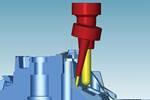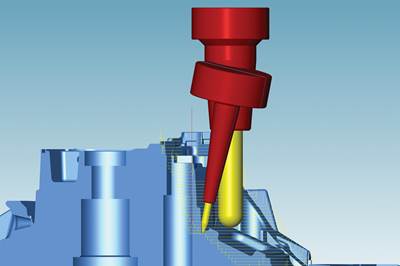CAD/CAM Software Suite Enhances Intelligent Workflow for Tool, Moldmaking Projects
IMTS 2024: Open Mind Technologies showcases its hyperMILL CAD/CAM software with enhancements to its toolpath capabilities, overall functionality and more.
Measuring points read back for improved quality and process control. The 3D model of the component shows, at a glance, which measuring points are outside the tolerance. Source (All Images) | Open Mind Technologies USA.
Open Mind Technologies is bringing its hyperMILL 2024 CAD/CAM software suite to the mold and die industry, with recently introduced updates that enhance a range of features, from the software’s core toolpath capabilities, to custom functionality for increased NC programming efficiency.
The software suite’s optimized deep-hole drilling CAM strategy is said to offer improved mold machining reliability by providing a user-friendly interface with process-relevant parameters clearly defined on a process tab. According to the company, these capabilities enable coolant and dwell time stages to be identified, permit a chip break to be integrated into a drilling process and more. A custom single-tip gundrill tool simulation function can provide precise collision checking and a detailed visualization of the stock removal.
An algorithm for three- and five-axis rest machining is also highlighted. It is said to ensure automatic, complete detection of all rest material areas, in addition to optimized toolpath calculations for faster, reliable machining. Tool paths are optimally divided to enable more efficient machining, and the detection of intersection areas where paths meet is optimized for collision avoidance.
An additional toolpath variation is a path layout for the hyperMILL 3D Plane Machining cycle. This strategy is designed for a smoother path and fewer pick-ups. While the toolpath length (distance) may be longer in some cases, the machining time, as tested on a variety of NC controllers, has been reduced.
The “CAM Plan” is included in hyperMILL 2024, designed to simplify various programming tasks and identify possible sources of error. Predefined workflow steps guide users through the preparation and programming process, while the geometries and features required are automatically created. Also, potential errors are flagged for removal such as double surfaces or gaps between model patches.
Once the data is organized, the CAM workflow can be processed with more intelligence and efficiency. According to the company, the first benefit from hyperMILL CAM Plan is that component topology is analyzed to produce a precise tool path that has command locations aligned with key geometric features and with optimized point distribution for milling. The results improve surface finishes, simplify processing by NC controllers and reduce machining times.
For simpler generation of three- and five-axis NC programs with axis change and an optimized use of the workspace, the NC Optimizer feature in the hyperMILL V Machining strategy offers the option to transform X- and Y-axis movements into a movement that uses the rotation axis in the table. By swapping axes, an XY movement is transformed into a simultaneous CX movement which eliminates rewind movements during machining. This can be especially impactful on machines that have a limited linear axis range.
The reading back of measuring points when using hyperMILL Virtual Machining is a feature that enables graphical representation of measured points on the part model, rather than comparing a list of measurement results. Users can also quickly identify measuring points that are out of tolerance on a 3D part model and compare trends over sequential measurements. As a result, it is much easier to analyze and compensate for inaccuracies and tool wear after milling.
Additionally, Open Mind, together with Oak Ridge National Laboratory (ORNL), is presenting “HEAL-IT: Hybrid-Manufacturing Enabled Agility and Longevity of Industrial Tools.” The presentation, led by David Bourdages, additive manufacturing product manager at Open Mind Technologies and Lauren Heinrich, R&D staff member at ORNL Demonstration Facility, focuses on a recent collaboration to repair a bottle mold using hybrid manufacturing (additive and subtractive machining). It takes place on Wednesday, Sept. 11 from 11:00 a.m. – 11:55 a.m. in Room W192-C, West Hall at McCormick Place.
Related Content
Mold Design Review: The Complete Checklist
Gerardo (Jerry) Miranda III, former global tooling manager for Oakley sunglasses, reshares his complete mold design checklist, an essential part of the product time and cost-to-market process.
Read MoreHow to Fix Predicted Warpage Before It Happens with Windage and CAD Model Morphing
Applying windage and model-morphing techniques saved toolmaker/molder Sturgis Molded Products the time, cost, headaches of multiple part/mold design iteration loops, cumbersome cooling fixtures, and long molding cycles.
Read MoreWhat Is Scientific Maintenance? Part 1
Part one of this three-part series explains how to create a scientific maintenance plan based on a toolroom’s current data collection and usage.
Read MoreWhat is Scientific Maintenance? Part 2
Part two of this three-part series explains specific data that toolrooms must collect, analyze and use to truly advance to a scientific maintenance culture where you can measure real data and drive decisions.
Read MoreRead Next
3D Printed Manufacturing Aids Improve Molding Efficiency
Moldmakers and molders turn to 3D printing for end-of-arm tools, fixtures for increased safety and functionality, lower cost and faster turnaround times.
Read MoreHow to Implement Five-Axis Mold Machining for Higher Productivity, Versatility
Understanding the basics of five-axis capabilities justifies the investment, but exploring all the multi-axis machine benefits and approaches enhances the return on investment.
Read MoreHow to Use Continuing Education to Remain Competitive in Moldmaking
Continued training helps moldmakers make tooling decisions and properly use the latest cutting tool to efficiently machine high-quality molds.
Read More























